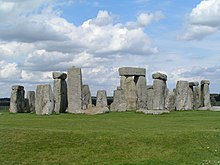
Back Neolithicum op de Britse Eilanden Dutch Ilhas Britânicas Neolíticas Portuguese Neolithic British Isles SIMPLE
| Geographical range | British Isles |
|---|---|
| Period | Neolithic |
| Dates | c. 4100 — c. 2500 BC |
| Preceded by | Neolithic Brittany, Mesolithic Britain, Mesolithic Ireland |
| Followed by | Bell Beaker culture, Bronze Age Britain, Bronze Age Ireland |


The Neolithic period in the British Isles lasted from c. 4100 to c. 2,500 BC.[1] Constituting the final stage of the Stone Age in the region, it was preceded by the Mesolithic and followed by the Bronze Age.
During the Mesolithic period, the inhabitants of the British Isles had been hunter-gatherers. Around 4000 BC, migrants began arriving from Central Europe. These migrants brought new ideas, leading to a radical transformation of society and landscape that has been called the Neolithic Revolution. The Neolithic period in the British Isles was characterised by the adoption of agriculture and sedentary living. To make room for the new farmland, the early agricultural communities undertook mass deforestation across the islands, which dramatically and permanently transformed the landscape. At the same time, new types of stone tools requiring more skill began to be produced, and new technologies included polishing. Although the earliest indisputably-acknowledged languages spoken in the British Isles belonged to the Celtic branch of the Indo-European family, it is not known what language the early farming people spoke.

The Neolithic also saw the construction of a wide variety of monuments in the landscape, many of which were megalithic in nature. The earliest of them are the chambered tombs of the Early Neolithic, but in the Late Neolithic, this form of monumentalization was replaced by the construction of stone circles, a trend that would continue into the following Bronze Age. Those constructions are taken to reflect ideological changes, with new ideas about religion, ritual and social hierarchy.
The Neolithic people in Europe were not literate and so they left behind no written record that modern historians can study. All that is known about this time period in Europe comes from archaeological investigations. These were begun by the antiquarians of the 18th century and intensified in the 19th century during which John Lubbock coined the term "Neolithic". In the 20th and the 21st centuries, further excavation and synthesis went ahead, dominated by figures like V. Gordon Childe, Stuart Piggott, Julian Thomas and Richard Bradley.
- ^ Adkins, Adkins and Leitch 2008. p. 37-38.
© MMXXIII Rich X Search. We shall prevail. All rights reserved. Rich X Search